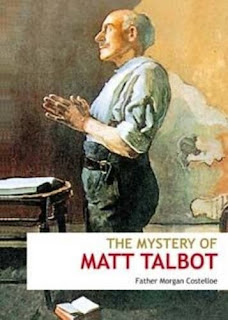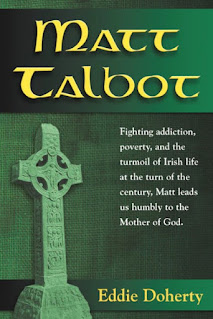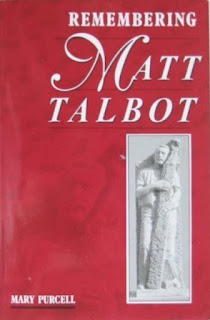The Mystery of Matt Talbot
Father Morgan Costelloe
Veritas
ISBN 9781853905483
2005
32p
This is one of two volumes written about Matt Talbot by Father Costelloe, who at the time of writing this volume was the Vice-Postulator for the cause of Venerable Matt Talbot, the other is titled The Mystery of Matt Talbot which was published in 1987, with reprints in 2001 and 2005 by the Irish Messenger Publications. This is one of several volumes I have read about Matt Talbot over the last year and a half, this is the tenth such volume, and I have at least that many I would still like to track down. This is one I finally found a copy of in my price range.
The description of this volume states:
“Matt Talbot: Hope For Addicts presents Venerable Matt Talbot as a providential and timely light in the dark ness and despair that is drug addiction, one of the scourges of the twenty-first century.
After a horrific struggle, Matt Talbot, a chronic alcoholic, eventually found sobriety through devotion to the Eucharist, prayer, self-discipline and spiritual direction. The Matt Talbot Retreat Movement has discovered that on his way to sobriety he covered the 'Twelve Steps Programme' of Alcoholics Anonymous. although they were not created until long after his death.
Pope John Paul II has proposed Matt Talbot as a model for drug addicts; hundreds of favours though his intercessions have been reported for addicts and their families throL1ghout the world; and in the United States, the Matt Talbot Retreat Movement for recovering alcoholics claims over 25,000 members.
Matt Talbot: Hope For Addicts is the ideal introduction to the story and inspiration that is Matt Talbot. In the words of a recovering addict ·1 believe that what God did for Matt he can do for me'.”
About the author we are informed:
“Fr Morgan Costelloe was appointed Vice Postulator for the Cause of Venerable Matt Talbot in 1974. Since then he has lectured and preached about him in Ireland. Britain, the United States and Australia. In 1990 he delivered the keynote address, 'Matt Talbot: A Man of the Eucharist', at the Calix International Convention in Lincoln, Nebraska. His first booklet is entitled The Mystery of Matt Talbot. Fr Costelloe is the parish priest of Beechwood Avenue, Dublin.”
I highlighted a few passages while reading this volume some of them are:
“But Matt Talbot, known to his drinking friends as 'Barney', did not return to O'Meara's. At that time he was a chronic alcoholic. His life was totally unmanageable. He was part of the drug culture of his day and today he would probably be a junkie. After a horrendous struggle he overcame his addiction through the grace of God.”
“The habit of heavy drinking passed from father to sons, and many years later, when most of the sons were working, the family were living at 5 Love Lane, Ballybough. The name of the district spoke for itself Ballybough - in Irish, Baile na mBocht – meaning the 'town of the poor'. It was their worst slum dwelling.”
“Matt's Dublin of 1856 was an overcrowded city. Its population of a quarter of a million had been swollen by the famine refugees of the forties. These unfortunates had fled the countryside when the potato crop failed and sought work in vain in the cities. Many chose Dublin rather than New York, Boston or Liverpool. There were more than sixty thousand people in the Dublin hovels in laneways and side streets, so there was no room for the new arrivals.”
“Matt Talbot grew up against that background of poverty and hopelessness. He went to school for the first time when he was eleven years old. It was long before the introduction of compulsory education and he really only enrolled in order to make his first Holy Communion and to receive the sacrament of Confirmation.”
“Together with his capacity to drink, Matt showed a tremendous capacity for work. He was small. Tenacious and very strong and acquired the reputation of being a first-rate hodman. Unfortunately, the pattern of life that would plague him for the next twelve years was taking shape. He was progressively spending more money and time after hours in a local public house. 'Barney' Talbot was a regular patron of O'Meara's on the North Strand.”
“After a while Phil walked away, but Matt retired to a nearby bridge and thought deeply about the rejection. He appeared to grasp 'suddenly and clearly the state of his life: a young man who had become a slave to drink, a person who had willingly endured great humiliation to satisfy his craving. The suddenness of his conversion has been compared with that of St Paul and St Augustine. The stubborn determination that characterised the rest of his life asserted itself: he would try to break the habit. He would take a pledge to abstain from alcohol for three months.”
“Matt went to Clonliffe College, the Dublin diocesan seminary, about a mile from his home. He asked to see a priest and went to Confession. He had been away from the sacrament for a number of years and while he never missed Sunday Mass - even though he regularly saw the priest and congregation through the haze of a hang-over - he had failed in other areas. It seems that his confessor gave him great encouragement. Matt took the pledge for three months. He left the College with a lighter step. The fight-back had begun”
“Even before he met Father Walshe, Matt had decided that he needed spiritual help to keep his pledge for three months. He resolved to attend Mass and receive Holy Communion every morning at 5.00 a.m. before going to work. It was a revolutionary idea in 1884, when pious laymen went to Mass only on Sunday and received the Eucharist just twice a year. But Matt concluded that he needed all the help he could muster to overcome the pressure and temptation to return to the drink. How right
he was!”
“As a result of that experience, he made a resolution that he kept for the rest of his life. He never carried money on his person. His reasoning was very simple: no money, no drink.”
“When Matt was drunk he lost his reason, but he never lost his faith. He did not desert God in his addiction and God did not desert him in his crisis. The Holy Spirit was prompting him. Matt found his 'Higher Power' quickly. Within a few hours of his conversion, he was on his way to Clonliffe College.”
“A good Confession means turning away from sin and turning one's will back to God. From the moment Matt Talbot went to Confession that Saturday he stood unflinchingly by that decision. He had a fierce struggle ahead but God would see him through. He turned to daily mass and reception of the Eucharist. He would survive from one encounter with Christ to another - an early form of 'one day at a time'. He dropped into a church in the evening to renew his strength by prayer and thank the Lord for another day without a drink. These were the early days of his conversion. Later he expanded his spiritual programme to imitate the rule of the early Irish monks.”
“Father James Walshe, whom Malt chose as his spiritual director, would help with these. But certain failings in justice would stand out in his mind that Saturday - unpaid debts and sins against justice, against his mother and the blind fiddle player. His confessor would have reminded him that these required restitution whenever Matt was in a position to make it.”
“Receiving that sacrament was not just a forgiveness or a cleansing for Matt. There was that aspect to it: ‘Though your sins are like scarlet they shall be as white as snow' (Is 1:18). But the Sacrament of Reconciliation was also the source of divine power that enabled him to reform his life.”
“He chose the rule of the early Irish monks. It was summarised by St Columbanus: 'Pray daily, fast daily, work daily, study daily'.”
“Many addicts have a low self- image. Sadly, they do not realise that every person is precious to God and has been redeemed by the blood of Christ. Pain, loss, or rejection is often behind an addiction and this brings us to the mystery of suffering. Acceptance can come by realising that all suffering acquires value when united with Christ's Passion. The Paschal Mystery - the suffering, death and resurrection of Jesus - tells us that pain, loss and rejection can bring us closer to God.”
“The credit for discovering that Matt Talbot practised almost all the 'Twelve Steps' within his recovery programme goes to the Matt Talbot Retreat Movement of the United States. It was founded in May 1942 as a non-profit corporation by a small number of recovering alcoholics. They were all members of Alcoholics Anonymous and were making a retreat at a Jesuit Retreat House in New Jersey. They had
retired for a few days to work on the spiritual steps of their programme.”
“The story of Matt Talbot has been an inspiration to its members for almost fifty years. They can identify with him easily. He understands their problems. For he was not just an alcoholic whose illness brought suffering to himself and his family, but he later saw one of his brothers die from the effects of excessive drinking. Matt's recovery shows that the conversion demanded by the 'Twelve Steps' programme
Is possible, even to the stage where the recovered addict becomes a candidate for canonisation.”
“This booklet is not intended to be a biography of Matt Talbot. It sets out to show that he was born into a subculture where drinking alcohol was almost inevitable. But. having become an addict, he fought his addiction primarily with a spiritual programme and recovered.”
“The fact that he practised almost all of the 'Twelve Steps' of the Alcoholics Anonymous programme fifty years before they were conceived makes Matt Talbot .a prophetic figure. His successful recovery gives hope to addicts while highlighting the need for a spiritual dimension in their rehabilitation.”
This was a fascinating read. It was very different than any of the other volumes about Matt I have read. And being written by the then postulator it was intriguing to see what he focused on compared to other works of this saintly man that I have read.
This book is an excellent resource. It is an amazing read, and I can easily recommend it. Matt is a man whose witness we need today even more than in his time. My own brother overdosed at the beginning of the pandemic in the spring of 2020. I wish I had discovered Matt and his story years ago to share with my brother. The number of people addicted to alcohol, weed, opioids and other drugs are constantly on the rise. I wish this volume was back in print and available as an eBook, there are dozens of people I would recommend it to. It is well worth tracking down and giving a read. I can easily recommend this for anyone struggling with addictions of for those with friends or family who struggle.
Note: This book is part of a series of reviews: 2024 Catholic Reading Plan!
For all reviews of books about Matt Talbot Click here.
Books about Matt Talbot:
Matt Talbot and His Times - Mary Purcell
Matt Talbot: His Struggle, His Victory over Alcoholism - Susan Helen Wallace
Matt Talbot - Xavier Carty
Spotlight on Matt Talbot - Edward O'Connor, S.J.
Matt Talbot - Simon O'Brynne
The quest for Matt Talbot - Philip Rooney
We knew Matt Talbot - Albert H Dolan
Matt Talbot - James F. Cassidy.
An address to Pope John Paul II from the Parish of Matt Talbot, The Worker.
Matt Talbot : the Irish worker's glory - James Francis Cassidy
Matt Talbot - Albon White
The Story of Matt Talbot - Malachy Gerard Carroll














No comments:
Post a Comment